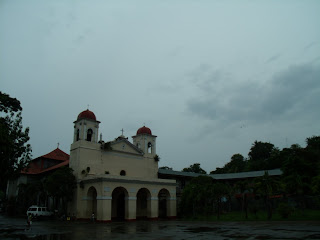Our usual Sunday routine was altered a bit when our friend announced, enroute to Quiapo church that we were about to take a road trip to Batangas after mass at the Black Nazarene in Quiapo. So instead of our usual breakfast at Binondo and weekly shopping sprees at 999, 1188 and 168 Malls we found ourselves motoring south to Taal, Batangas.
About two-hour's drive from Manila, the town of Taal which is famous for its balisong ang panutsa (brittle peanut). The Bassilica of Taal, built by the Augustinians, with its massive baroque architecture reigns supreme as its main landmark. On this particular Sunday that we visited, the church area and a few streets were closed to vehicular traffic due to a period film being shot on location there. Much as I would have liked to re-visit the church, we had to make a few detours and we ended up in the Chapel of Caysasay.
The Chapel of Our Lady of Caysasay
A most revered and visited image of the Blessed Virgin Mary is the Our Lady of Caysasay. The image is enshrined in Taal, Batangas (in itself a heritage town). The image is said to be miraculous and is, like every other Marian image found all over the world situated near a source of water.
The arch marking the miraculous well
The carved image of pine wood is 225 mm tall and as legend has it, was fished out of the Pansipit River by Juan Maningkad (then chieftain of the town) in 1603. The image was brought to Fr. Juan Montoya who entrusted it to Maria Espiritu. The latter then placed it in a precious urn for safekeeping.The image was later ensconced in a special niche high in the church's main altar after it had been clothed with pure gold by Fr. Marcos Anton.
The venerated image of Lady of Caysasay
The image, according to legend would habitually disappear from the said niche ad reappear miraculously. On one occasion after its disappearance from the altar, two women Maria Baguhin and Maria Talain who were out gathering firewood and drawing water near a well found the image of our Lady atop a sampaga tree and guarded by a kingfisher locally called casay-casay. The Spaniards mispronounced it as Caysasay which has been retained to this day.
The well with its miraculous healing waters
Because the locals believe that the Image of Our Lady of Caysasay refuses to stay still in its niche, it is moved from the Taal Bassilica every Thursday and moved back on Saturday afternoon. Devotees of Taal lovingly refer to her as Birheng Gala (Wandering Virgin). Her feast Days are celebrated on the 8th and 9th of December. Incidentally, the image of Our Lady of Caysasay was canonically crowned on the 8th of December 1954 by Cardinal Fernando Quiroga y Palacios, Archbishop of Santiago de Compostela Valley.






No comments:
Post a Comment